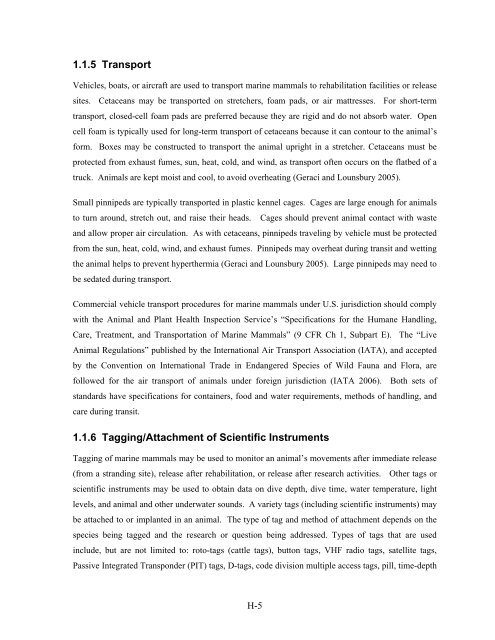Volume III, Appendices EM - National Marine Fisheries Service ...
Volume III, Appendices EM - National Marine Fisheries Service ...
Volume III, Appendices EM - National Marine Fisheries Service ...
Create successful ePaper yourself
Turn your PDF publications into a flip-book with our unique Google optimized e-Paper software.
1.1.5 Transport<br />
Vehicles, boats, or aircraft are used to transport marine mammals to rehabilitation facilities or release<br />
sites. Cetaceans may be transported on stretchers, foam pads, or air mattresses. For short-term<br />
transport, closed-cell foam pads are preferred because they are rigid and do not absorb water. Open<br />
cell foam is typically used for long-term transport of cetaceans because it can contour to the animal’s<br />
form. Boxes may be constructed to transport the animal upright in a stretcher. Cetaceans must be<br />
protected from exhaust fumes, sun, heat, cold, and wind, as transport often occurs on the flatbed of a<br />
truck. Animals are kept moist and cool, to avoid overheating (Geraci and Lounsbury 2005).<br />
Small pinnipeds are typically transported in plastic kennel cages. Cages are large enough for animals<br />
to turn around, stretch out, and raise their heads. Cages should prevent animal contact with waste<br />
and allow proper air circulation. As with cetaceans, pinnipeds traveling by vehicle must be protected<br />
from the sun, heat, cold, wind, and exhaust fumes. Pinnipeds may overheat during transit and wetting<br />
the animal helps to prevent hyperthermia (Geraci and Lounsbury 2005). Large pinnipeds may need to<br />
be sedated during transport.<br />
Commercial vehicle transport procedures for marine mammals under U.S. jurisdiction should comply<br />
with the Animal and Plant Health Inspection <strong>Service</strong>’s “Specifications for the Humane Handling,<br />
Care, Treatment, and Transportation of <strong>Marine</strong> Mammals” (9 CFR Ch 1, Subpart E). The “Live<br />
Animal Regulations” published by the International Air Transport Association (IATA), and accepted<br />
by the Convention on International Trade in Endangered Species of Wild Fauna and Flora, are<br />
followed for the air transport of animals under foreign jurisdiction (IATA 2006). Both sets of<br />
standards have specifications for containers, food and water requirements, methods of handling, and<br />
care during transit.<br />
1.1.6 Tagging/Attachment of Scientific Instruments<br />
Tagging of marine mammals may be used to monitor an animal’s movements after immediate release<br />
(from a stranding site), release after rehabilitation, or release after research activities. Other tags or<br />
scientific instruments may be used to obtain data on dive depth, dive time, water temperature, light<br />
levels, and animal and other underwater sounds. A variety tags (including scientific instruments) may<br />
be attached to or implanted in an animal. The type of tag and method of attachment depends on the<br />
species being tagged and the research or question being addressed. Types of tags that are used<br />
include, but are not limited to: roto-tags (cattle tags), button tags, VHF radio tags, satellite tags,<br />
Passive Integrated Transponder (PIT) tags, D-tags, code division multiple access tags, pill, time-depth<br />
H-5
















